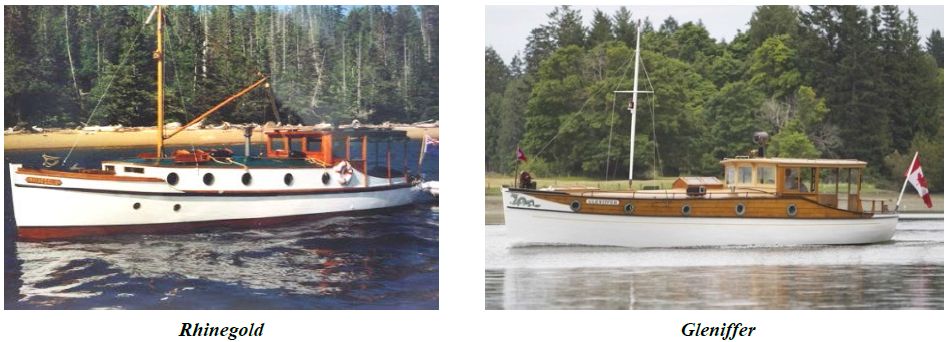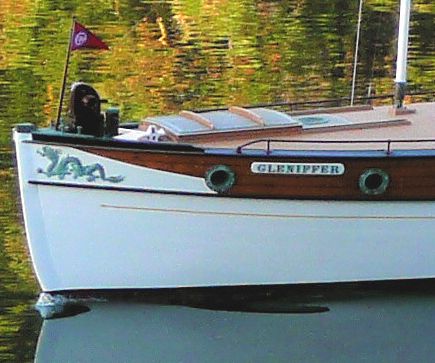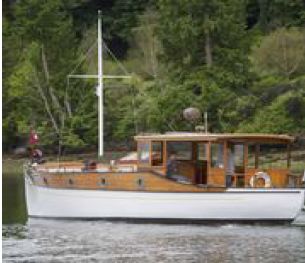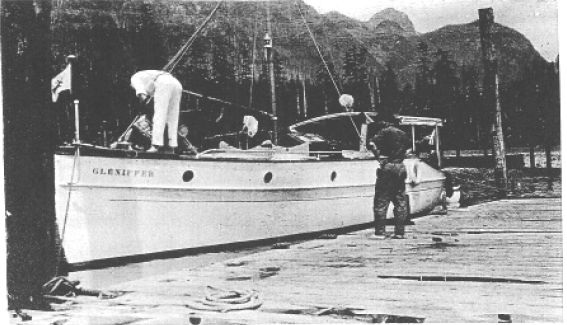By Randall Olafson, Canadian Fleet Director. Excerpted from December 2012 "Classic Yachting" CYA newsletter.
![Gleniffer in Glenthorne Passage, (BC Gulf Islands), August 2012. [Rick Etsell photo] Gleniffer in Glenthorne Passage, (BC Gulf Islands), August 2012. [Rick Etsell photo]](/sites/default/files/users/u1/glennifer-sept-2012.jpg)
As I pondered about the content of my article for this newsletter, I remembered that last year and again this year two others of our CAN Fleet members' yachts turned 100 years old. We recognized the 100th anniversaries of Rhinegold in 2011 and Adelante in 2012. I then recalled when I joined the Royal Vancouver Yacht Club in the 1970s there were still plenty of wood boats around that were all in great condition. At that time I had a 32-foot wood Chris-Craft that was perfect for my wife and me and our growing children. However, while I was working away keeping our Chris-Craft up to snuff, our boat was located between a bevy of unique one-of-a-kind vessels that not only included both the masterpieces pictured on the next page but many other boats that have passed through the RVYC floats. Thus I could not think of a better article than acknowledging Tom Burnett's beautifully preserved coastal cruiser Gleniffer who turned 100 years young this year.
It's actually interesting to note that, although Rhinegold (the book Antiques Afloat tells the story of her name which is reported to be a misspelling of 'Rheingold' from the Wagnerian opera. The tale revolves around the recovery of gold stolen from the fairies of the Rhine River) is almost 4 feet shorter than Gleniffer, there is a striking similarity in the method of construction for both of these gracious yachts – even though Rhinegold was built in Vancouver, BC, and Gleniffer was built in Hong Kong.

If you study the pictures, one can't help wondering if these cruisers were influenced by the European Marine Architects of the time. The style or designs of the time were planned around a need for a comfortable cruiser so the affluent adventurers could elegantly cruise adjacent shores or the waterways of Europe. It is an interesting viewpoint as these cruisers were built 5,500 miles apart but at almost the same time – you be the judge.
 Gleniffer was designed and built in Hong Kong by the W. S. Bailey Company, an engineering company that was involved in the importing and exporting of steam engines and related parts. The company had a shipyard and an extensive machine shop that was located in Kowloon Bay on the outskirts of Hong Kong. By 1912 it had a thriving marine business located right on the shores of the bay. The founder William Seybourne Bailey served his apprenticeship as an engineer with the Australian Steam Navigation Company and arrived in Hong Kong in 1890, working for the Hong Kong, Canton and Macao Steamboat Company until he started his business in 1907. His business closed in 1960; William Seybourne Bailey died at the War Memorial Hospital in Hong Kong, on December 27, 1936, at the age of 76. It was on the shores of Kowloon Bay that the keel for Gleniffer was first laid and she was completed in the fall of 1912.
Gleniffer was designed and built in Hong Kong by the W. S. Bailey Company, an engineering company that was involved in the importing and exporting of steam engines and related parts. The company had a shipyard and an extensive machine shop that was located in Kowloon Bay on the outskirts of Hong Kong. By 1912 it had a thriving marine business located right on the shores of the bay. The founder William Seybourne Bailey served his apprenticeship as an engineer with the Australian Steam Navigation Company and arrived in Hong Kong in 1890, working for the Hong Kong, Canton and Macao Steamboat Company until he started his business in 1907. His business closed in 1960; William Seybourne Bailey died at the War Memorial Hospital in Hong Kong, on December 27, 1936, at the age of 76. It was on the shores of Kowloon Bay that the keel for Gleniffer was first laid and she was completed in the fall of 1912.
Upon completion, she was transported to Vancouver, BC, on the deck of a freighter and delivered to her first owner Mr. Stuart Cameron. Upon taking possession of the vessel, Mr. Cameron added a few creature comforts and had her commissioning ceremony in Coal Harbour, Vancouver. After her official commissioning, the documents were sent to the Canadian Registry of ships. After document processing, Gleniffer officially became a registered vessel in Canada on February 7, 1913, and was finally free to continue her 100 year adventure. Many times during their lives, both vessels anchored or met up from time to time in coves or anchorage locations around the coast.
Gleniffer tips the scales at just over 10 tons and has a 9' 6" beam. Construction of the vessel was typical for that time, carvel planking of 1" Burma teak planks over the 1-3/8" x 1-7/8" teak ribs. The planks are held in place with copper rivets and bronze bolts. The lower portion of the keel has a section of lead scarfed into it to keep her trim. While her fittings were modest they were custom cast for her including her bow apron, stem cap, and fairleads.
 Driving her 40 foot hull through the water today is a Nissan Chrysler diesel. However, when she was imported into Canada she was fitted with a 25hp Lycoming gasoline engine. While in the Royal Vancouver Yacht Club, she was purchased by a RVYC past Commodore R.M. Maitland, and her main engine was replaced with a more powerful 61hp Kermath gasoline engine. After that, she was sold to J.C. McPherson who installed a 75hp Chrysler Crown gasoline engine. Ken Mair, the brother of Rafe Mair who was a former BC Cabinet Minister and outspoken political broadcaster and writer on public affairs, installed the current diesel engine.
Driving her 40 foot hull through the water today is a Nissan Chrysler diesel. However, when she was imported into Canada she was fitted with a 25hp Lycoming gasoline engine. While in the Royal Vancouver Yacht Club, she was purchased by a RVYC past Commodore R.M. Maitland, and her main engine was replaced with a more powerful 61hp Kermath gasoline engine. After that, she was sold to J.C. McPherson who installed a 75hp Chrysler Crown gasoline engine. Ken Mair, the brother of Rafe Mair who was a former BC Cabinet Minister and outspoken political broadcaster and writer on public affairs, installed the current diesel engine.
Along the way, many changes took place with small modifications here and there but since the major work done to her (the enclosing of the dog house in the late 20's) she remains the same. The picture below is Gleniffer at the docks in Indian Arm around 1925. Note the original baton and canvas bimini with roll up sides, oil stove stack, and the completely painted hull up to the deck.
There is still a copper water tank in the bow and gear shifting at the helm is still done with the original brass wheel. Once the more efficient and safer Nissan Chrysler diesel was installed, it allowed her to make passages that were further than previously attainable with a capacity of 100 gallons of diesel fuel held in two 50 gallon stainless steel tanks.
Gleniffer’s owner, Mr. Tom Burnett, cruises the Southern Gulf Islands and beyond comfortably from his boathouse located on Salt Spring Island, BC. Tom is a veteran coastal towboat master and a long-standing member with the Canadian Merchant Service Guild. Gleniffer will be around for many more years as she continues to be pampered and maintained by Tom.
Happy 100th Birthday to Gleniffer!

Links: Gleniffer Boat Page | Rhinegold Boat Page | Dec 2012 Classic Yachting Newsletter

Classic Yacht Register
Classic Yacht Association